This is the first in a planned series in which I, Emma the Intern, report Kurt Vonnegut’s opinion on a certain topic, drawing mostly on his published works. Please forgive me if I omit your favorite work in my discussion. I have not yet read everything by Vonnegut, but I’m working on it.
Many people ask us when they first enter the museum, “Why is there a Vonnegut museum in Indianapolis, of all places?” For those not familiar with Kurt’s early life, it’s a valid question. The answer is that Kurt was born and raised in Indianapolis, and his family lived in the city for generations – his great-grandfather, Clemens Vonnegut, came here from Germany in 1850 – but after World War II, Kurt never lived here again. Indianapolis refused even to acknowledge him until it declared 2007 the Year of Vonnegut, an event complicated somewhat by its honoree’s death less than halfway through it. But Kurt loved the place anyway.
People who aren’t Kurt Vonnegut seem to have plenty of reasons to dislike Indianapolis. One museum visitor said the city had the worst urban planning he had ever seen. (How could you keep from loving those six-way intersections and haphazardly placed residential areas?) “Didn’t [Vonnegut] say it was the armpit of the universe?” said another visitor.
If he did, he didn’t mean it. Kurt complimented the city of his birth much more than he criticized it.
Kurt’s love for his hometown began when he was a young boy. He had originally been enrolled in private school, but when his family lost all their money in the Great Depression, he was sent to public school. His mother railed against this injustice for most of Kurt’s school-going life, promising him that someday he’d return to private school. Kurt always retorted that he liked public school better. He must have been telling the truth; later in life, he would claim that the most radical ideas in his writings came from the public schools of Indianapolis.

Vonnegut’s childhood home.
Indianapolis also shows up in Kurt’s writing style. In his essay “How to Write with Style,” Vonnegut says growing up in Indianapolis influenced his voice as a writer. He isn’t totally deaf to criticism of his hometown, admitting that its “common speech sounds like a band saw cutting galvanized tin, and [it] employs a vocabulary as unornamental as a monkey wrench.” But he later says, “All these varieties of speech are beautiful, just as all the varieties of butterflies are beautiful.” And, yet later, “I myself find that I trust my own writing most, and others seem to trust it most, too, when I sound most like a person from Indianapolis, which is what I am.”
Careful and avid Vonnegut readers will have noticed that his fiction often references Indiana and Indianapolis. Hazel, a character in Cat’s Cradle, fusses over every Hoosier she meets and tells them why they’re better than residents of any other state: “‘Hoosiers do all right . . . everywhere we went we found Hoosiers in charge of everything.'” She also insists that her younger Hoosier acquaintances call her “Mom.”
Vonnegut makes fun of Hazel’s Hoosier obsession, calling it a “a textbook example of a false karass, of a seeming team that was meaningless in terms of the ways God gets things done . . .” But Hazel also says, “Nobody has to be ashamed of being a Hoosier,” and Kurt maintained the same thing to the end of his life. He scorned anyone who claimed the Midwest was populated by “flyover states.” In “Don’t Forget Where You Come From,” a speech he gave at Butler University’s 1996 commencement, he mentions a few famous Hoosiers, including Abraham Lincoln (for a short time, and he was still a Midwesterner the rest of the time) and Madeline Pugh, head writer for I Love Lucy, who actually went to high school with Kurt.
“I went to high school with at least thirty people who were as funny as David Letterman,” said Kurt. “There’s something about the air here.”

A mural of the man himself on Massachusetts Avenue.
In a letter to Indianapolis’s Junior League, written at about the same time as the Butler speech, Kurt bemoaned the beautiful and rich but overlooked history of his home city. “We haven’t been in a movie? Is that the problem?” he said. (We have now. Thanks, John Green.)
As Kurt mentions in Fates Worse than Death, Indianapolis was founded on the highest principles of equality: by drawing an X over our clumsy cowboy boot of a state and choosing the axis point for the site of the capital. Even his Sirens of Titan character Malachi Constant, at one point the richest man in America, has a good word to put in for Indianapolis:
“Indianapolis, Indiana,” said Constant, “is the first place in the United States of America where a white man was hanged for the murder of an Indian. The kind of people who’ll hang a white man for murdering an Indian-” said Constant, “that’s the kind of people for me.”
Us too.



